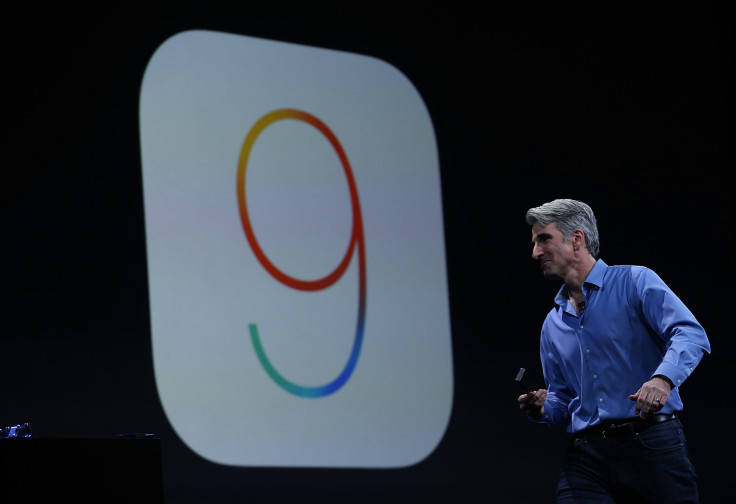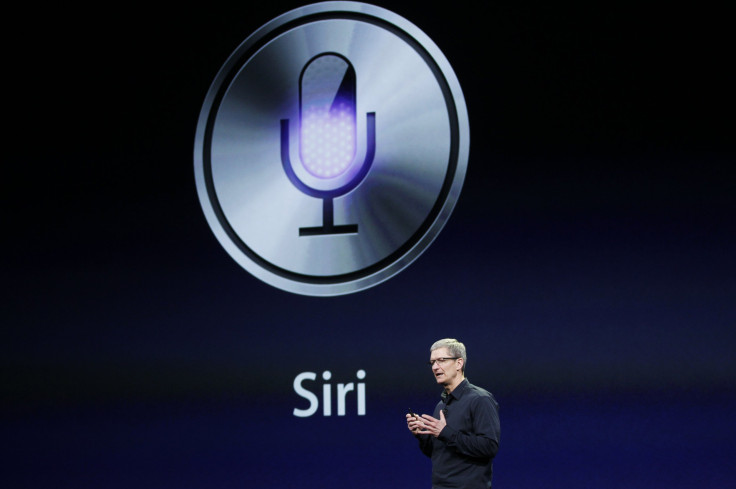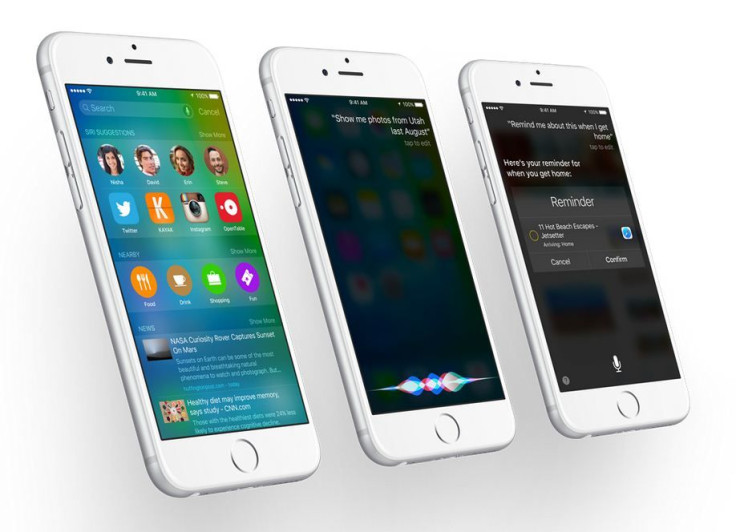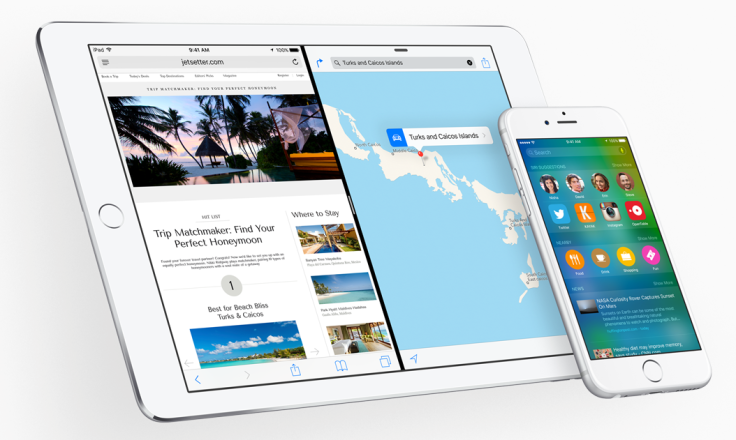iOS 9: The 5 Most Important Features Of Apple Inc.’s New iPhone And iPad Software

Apple is releasing new iPhones, an iPad Pro and a new Apple TV today, but its new iOS 9 software could be the most important thing it launches in San Francisco's Bill Graham Civic Auditorium.
On fist look iOS9 won't seem like a major upgrade to iOS 8, which was a significant update in terms of look and feel, and it won't be anything like the complete redesign that was iOS 7. However, just as the iPhone 6s updates are almost all on the inside, the updates to iOS 9 will have a huge impact on those using iPhones and iPads on a daily basis.
We have been using the beta version of iOS 9 on an iPhone 6 Plus for a number of weeks and together with insight from apps developers and the promises Apple is making about the final version of its latest software, here are the five key aspects if iOS 9 we think are the most interesting for iPhone and iPad users.
1. Siri Could Finally Be Useful
Siri got there first, but since the launch of Google Now and Microsoft’s Cortana it has been left behind in terms of usefulness and usage. While Cortana and Google Now will actively engage with users, proactively offering suggestions based on the user’s actions, location and what time it is, Siri simply sits there waiting to be asked a question.
That is all about to change in iOS 9, with a new feature called Proactive, which will see Siri actively suggest things like calendar reminders to users based on location and time. This is certainly a step in the right directions but due to Apple’s own privacy restrictions, it could be a pale imitation of Cortana and Google Now.

Having tested the feature in beta versions of iOS 9, we found very little difference, but Apple has said the system needs time to learn and get to know the user so hopefully with the final version of the software things will improve in this area.
The problem for Apple is that while Google and Microsoft send users’ information anonymously to the cloud, Apple keeps everything on your iPhone or iPad, and while this is good for privacy concerns, it means giving up the power of cloud computing.
But Siri’s updates in iOS 9 are not just about Proactive. It will now allow you to search more naturally through your iPhone for say “photos of my trip to Germany last year." You will also be able to get Siri to quickly add a reminder about what you are doing right now, such as “remind me about this email tomorrow.”
Apple is also updating the "Hey Siri" voice control function to now work even when your iPhone or iPad is not plugged in, which should also increase user interaction.
2. Better Battery Life Is A Reality
Better battery life always tops smartphone users’ wish lists when asked what they want from a next generation phone. One way of doing this is to cram in a bigger battery and just last week at IFA we saw both Asus and Lenovo do just that by launching phones with huge 5000mAh batteries.
Apple however was never likely to sacrifice the sleek lines of its iPhone 6s and iPhone 6s Plus and so it has turned to tweaking its software to help improve battery life — and it works. Not only is iOS 9 less power hungry in thew way it manages your apps, Apple has also added a new Low Power Mode, found in the Battery settings menu, which will allow you adjust a range of settings automatically which have never before been accessible.
Low Power Mode can be turned on to kick in when your battery dips under 20 percent and it will kill power-hungry features like push email and any other background processes which can eat into battery life.
Apple is also utilizing its ambient light and proximity sensors so that your screen won’t turn on if your iPhone is face down on a tablet, even if you get a notification. Apple says that all this will add one hour of extra battery life to your iPhone but in our testing we found that it was easily getting us through to mid-way through day two on a single charge.
3. Ad Blocking Isn't Such A Big Deal
There has been a lot of fuss about the ad-blocking feature on iOS 9. We have seen some headlines which claim it heralds the end of the online publishing industry but the truth is very different.
Ad blocking will be built into iOS 9, but in order to use it, iPhone and iPad users will need to first download an ad blocking app -- such as Ad Blocker Plus -- then go into Content Blocker in the Settings menu and activate the particular app you have downloaded. And even then, ad blocking in iOS 9 will only work on Safari, not on any third party browsers or in any apps.

Therefore, as Naji El-Arifi, a product innovation manager at digital marketing company Somo, points out, the number of people this will affect is pretty small. “Already that has narrowed down the number of people who will be affected by it so I don’t think desktop web advertising will take a big hit," he said.
The reason Apple has introduced ad blocking is in a bid to control the mobile web experience on its iPhone and iPad, and with multiple ads flashing up on websites these days, it is not a great experience and can also eat into your data allowance significantly. This feels like the first step on a long road to change the mobile web experience, but ad blocking in iOS 9 is not going to kill the publishing industry.
4. App Indexing Is More Interesting Than It Sounds
This may not sound like the most exciting development in the world but it is one which will make the Spotlight search in iOS 9 hugely powerful. App developers will now be able to add deep links to their apps which will allow the system wide search to give users much more tailored results within apps, and not just to the apps themselves.
El-Arifi told International Business Times that "if you want to deep link into the application to the content that you are looking for then you need to have the app installed.”
One example given by El-Arifi is travel comparison app Kayak. With app indexing someone with the app installed searching for a luxury holiday in Dubai will be brought directly to the page they are looking for rather than simply the front page of the app, or the website’s homepage.
El-Arifi points out that which people increasingly having 100s of apps installed on their iPhones and iPads search is becoming a very important tool for people. The new system will allow users to simply type in departure time and instantly get the right app and the right page in that app.
5. Multi-Tasking For The Enterprise
Apple needed to do something to reignite interest in its tablet range and while the new iPad Pro hardware will certainly do that, just as important are the new multi-tasking capabilities of iOS 9.
The new software has three multitasking features which will likely appeal to enterprise customers. Slide Over allows you to quickly open a second app without leaving the main app you are working in, to quickly respond to a message, browse Twitter or search the web. Split View is something we saw introduced on Windows 8 and allows you to snap two apps onto the screen at once and work in both simultaneously. Finally Picture-in-Picture allows you continue watching a video or taking a FaceTime call while using other apps, again a feature we have seen done before on many Android devices.

El-Arifi however warns that apps will not simply work with the new multi-tasking features but need to be coded for them and he says developers “should be thinking about [their apps] as they do a responsive website.”
Multi-tasking will be key to help Apple boost its falling iPad sales, with its partnership with IBM to develop closer ties with business and tailored apps for the enterprise likely to get more important with the launch of iOS 9 and the iPad Pro.
© Copyright IBTimes 2024. All rights reserved.





















